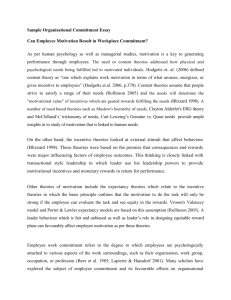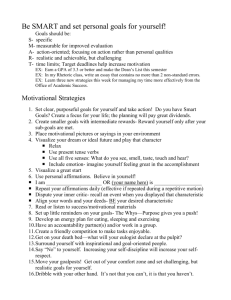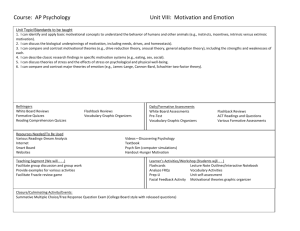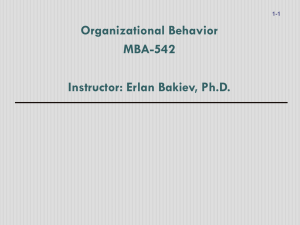Employee Motivation: “Just Ask Your Employees” - S
advertisement
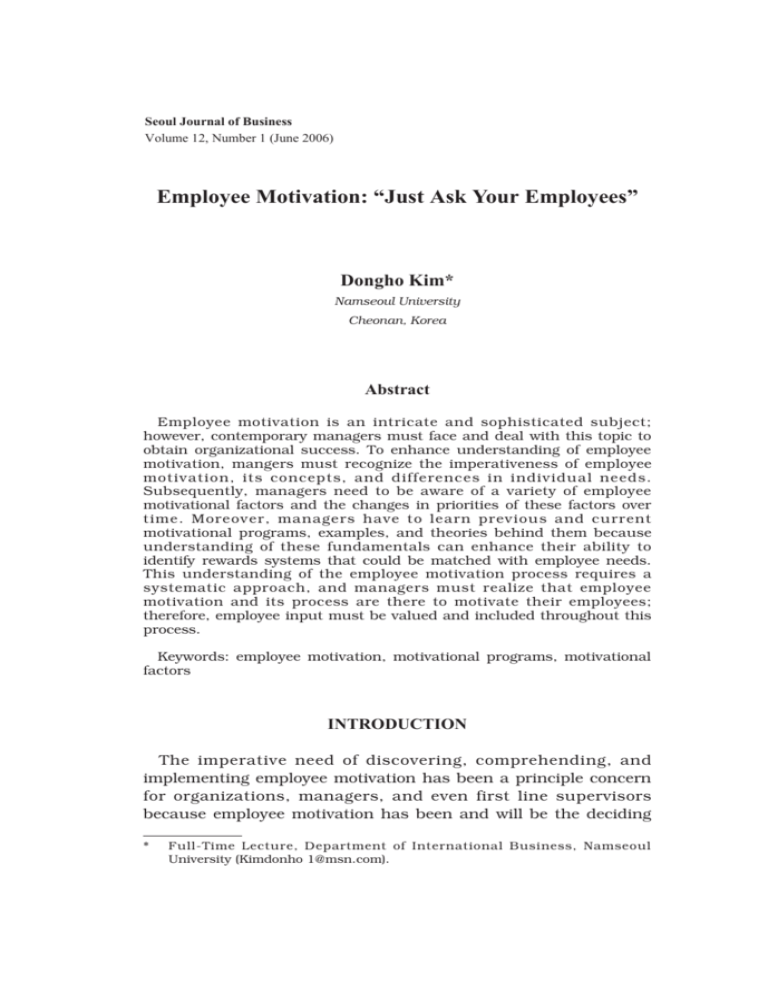
Seoul Journal of Business Volume 12, Number 1 (June 2006) Employee Motivation: “Just Ask Your Employees” Dongho Kim* Namseoul University Cheonan, Korea Abstract Employee motivation is an intricate and sophisticated subject; however, contemporary managers must face and deal with this topic to obtain organizational success. To enhance understanding of employee motivation, mangers must recognize the imperativeness of employee motivation, its concepts, and differences in individual needs. Subsequently, managers need to be aware of a variety of employee motivational factors and the changes in priorities of these factors over time. Moreover, managers have to learn previous and current motivational programs, examples, and theories behind them because understanding of these fundamentals can enhance their ability to identify rewards systems that could be matched with employee needs. This understanding of the employee motivation process requires a systematic approach, and managers must realize that employee motivation and its process are there to motivate their employees; therefore, employee input must be valued and included throughout this process. Keywords: employee motivation, motivational programs, motivational factors INTRODUCTION The imperative need of discovering, comprehending, and implementing employee motivation has been a principle concern for organizations, managers, and even first line supervisors because employee motivation has been and will be the deciding * Full-Time Lecture, Department of International Business, Namseoul University (Kimdonho 1@msn.com). 20 Seoul Journal of Business factor in work performance and in turn decide the success or failure of an organization. Consequently, considerable study and research of this topic has been conducted, and reasonable amounts of findings have been produced to benefit contemporary organizations and management. The study and research of this topic will continually be a major task for modern and prospect psychologists, Organizational Behavior (OB) researchers, and scholars from management and organizational related fields as long as the significance of employee motivation can affect an organizations’ success. The purpose of this paper is to reemphasize and analyze some necessary components of employee motivation, so contemporary managers; especially those who are inexperienced can enhance their knowledge and understanding of employee motivation. This paper explains the importance of employee motivation, describes the concept of motivation, and identifies different motivators and priority changes in motivators over time. Some motivational programs and their examples are introduced and briefly described, and several theories and its organizational implications are identified and explained. This report suggests a sequential process of understanding employee motivation and that employee input must be valued and included in this process. THEORETICAL BACKGROUND Employee Motivation The significance of employee motivation, influencing the behaviors of their employees to behave in certain ways, can ultimately decide the success or failure of an organization. Kovach (1987) suggests that if a company knows why its employees come to work on time, stay with the company for their full working lives, and are productive, then the company may be able to ensure that all of their employees behave in that way. Such a company would have a decided marketplace advantage over competitors suffering from absenteeism, costly re-training programs, and production slowdowns (p.58). Moreover, Wiley (1997) also suggests ensuring the success of a company, Employee Motivation: “Just Ask Your Employees” 21 employers must understand what motivates their employees, and such understanding is essential to improving productivity (p. 271). These suggestions imply that organizational success depends heavily on employee motivation, and managers must understand what motivates their employees in order to motivate their employees. Understanding the concept of motivation could assist incompetent and inexperienced managers, in terms of employee motivation, identify what motivates their employees. The concept What is motivation? Helliegel, Slocum, and Woodman (1992) describe motivation as the force acting on or within a person that causes the person to behave in a specific, goal-directed manner (p.204). Reece and Brandt (1990) suggest that motivation can be defined as the reason why people do the things they do, and in a work setting, motivation is what makes people want to work (p.149). Finally, Daft and Marcic (2004) explain that motivation refers to the forces either within or external to a person that arouse enthusiasm and persistence to pursue a certain course of action (p.444). These concepts of motivation suggest that motivation has something to do with a person’s behavior, a cause of behavior, or the reasons of individual behavior, and the causes of individual behaviors may differ because of different individual needs. The intuition of these concepts to managers is that they must first understand and discover these individual differences and their needs, and develop proper models to motivate employees by fulfilling these different needs toward common organizational objectives. Therefore, organizations and managers should not limit themselves to one specific motivational factor; instead, they should consider diverse motivational models to realize the different needs of employees. Kovach (1987) supports this suggestion by saying that no standard motivational factor is applicable to all organizations because of individual differences. For example, what is interesting to one person may not be interesting to someone else: one employee may value good wage while the other may prefer interesting work (p.58). A simple model of human motivation also concluded that a person’s satisfaction can be received in the process of performing 22 Seoul Journal of Business an action, intrinsic rewards, and others could receive their satisfaction from rewards given by the others, such as a promotion given by a manager, extrinsic rewards (Daft & Marcic, 2004, p.445). A variety of employee motivational factors have been identified and studied over the years and used by organizations to enhance managers’ understanding of employee motivation. The research findings in the next section clearly indicate that employees are motivated by different reasons and their values change over time. Motivational factors Wiley (1997) suggests that there are some motivators that employees value over time; however, the most preferred motivators have changed over the last 40 years. She refers to the survey results of 1946 by the Labor Relations Institutes of New York reported in Foreman Facts, similar surveys administered in 1980 and 1986 (Kovach, 1984 &1987), and lastly her survey in 1992. Table 1 indicates ten motivators that employees were asked to rank. The top motivator selected by employees in 1946 was full appreciation of work done. Good wages ranked in the middle and interesting work ranked at number 7. In 1980 and 1986, employees’ top concern was interesting work, followed by full appreciation of work done with good wages and job security Table 1. The “Factors That Motivate Me” Motivators Full appreciation of work done Feeling of being in on thing Sympathetic help with personal problems Job security Good wages Interesting work Promotion and growth in the organization Personal loyalty to employees Good working conditions Tactful discipline 1946 1980 1986 1992 1 2 3 4 5 6 7 8 9 10 2 3 9 4 5 1 6 8 7 10 2 3 10 4 5 1 6 8 7 9 2 9 10 3 1 5 4 6 7 8 Note. From Wiley, C. (1997). What motivates employees according to over 40 years of motivation surveys. International Journal of Manpower, 18 (3), 263-281. Employee Motivation: “Just Ask Your Employees” 23 near the middle. However, the respondents to the 1992 survey showed more concern for good wages followed by full appreciation of work and job security (pp.264-269). These surveys proved that the priorities of employee motivational factors changed over time, and there is more than one reason why these changes occurred. The reasons may be economic conditions, change of working environment or industries, labor market conditions, industry competitions, change in workers attitude, etc. For instance, Grayson and O’Dell (1988) explained that when World War II ended, U.S. productivity soared: benefiting from new technology, flexibility in labor force, and labor-management-government cooperation (p. 61). Soared productivity and flexibility in labor force could have boosted an employment rate which in turn increased wage rates; therefore, employees were probably more concerned with intrinsic rewards during this period, such as full appreciation of work done, feeling of being in on things, and sympathetic help with personal problems. Furthermore, employees could have valued intrinsic rewards because having a job itself was satisfying their needs, a motivational factor, more than good wages or promotions due to the depression and war prior to this period. In the 1980s, with almost forty years of relative prosperity and a rise in the standard of living beyond the imagination of workers in mid 40s, what workers wanted changed, however the findings of both 1980 and 1986 surveys supported that employees still valued intrinsic rewards, but not in terms of sympathetic help with personal problems. “Interesting work” was first, followed by full appreciation of work done and feeling of being in on things (Kovach, 1987, p.59). A national random sample of 845 jobholders by the non-profit Public Agenda Foundation confirmed this indication. Its findings indicated that an impressive shift in attitudes towards work had developed, from work as a means of survival to work as a means of enhancing self-development and self-expression (Goddard 1989, p.7). By the 1990s, it seems that workers valued more extrinsic rewards than intrinsic rewards. Good wage was chosen as the top motivator, full appreciation of work done next, followed by job security. Wiley (1997) reasoned that period-hostile takeovers, global competition, and organizational transformation and 24 Seoul Journal of Business downsizing created an environment that placed workers in a position of insecurity and uncertainty. Consequently, workers could have been more concerned with basic needs in this period: good wages and job security (p.23). Increases in organizational downsizing, global competitions, and outsourcing have been described as general economic conditions for the last decade. Consequently, both organizational downsizing and outsourcing could have increased employees’ workloads and feelings of job insecurity. These indications imply that current top motivators would still be job security and good wages. These motivational factors and changes in employee values due to different reasons can help current and future managers understand and discover the different needs of their workers, and make it easier for managers to choose and apply motivational programs that can be linked to the appropriate motivation theories. Many programs have evolved for the purpose of attracting, maintaining, and motivating employees, and prior behavior in the evolution of these programs show that new programs will continue to be developed as work environments and employees’ value change. Furthermore, a significant amount of theory building and research has focused on what energizes human behavior, and how certain behaviors can be sustained or maintained over time (Bowditch and Buono 1997, p.87). Furthermore, the major reason to study the theories of human behaviors is that good theory provides a basis for understanding, explaining, and predicting what will happen in the real world (Marrow 1965, p.7). Therefore, comprehending and knowing many theories may assist managers to design, develop, and implement appropriate motivational programs for their employees. Programs, examples, and linked theories For the purpose of this paper, this section will only identify and provide explanations of programs, theories, and examples from the work of Robbins (2005) to show managers how to identify, select, and link motivational programs to proper theories or vice versa. Table 2 shows that motivational programs are divided in two major categories, intrinsic and extrinsic 25 Employee Motivation: “Just Ask Your Employees” Table 2. Types of Motivational Programs, Examples, and Linked Theories Type of Rewards Programs Examples Theories Employee Recognition Thank you notes, Certificates of appreciation Reinforcement Theory Employee Involvement Participative management, Quality Circles, Employee Stock ownership ERG Theory Job Redesign & Scheduling Job sharing, rotation, enlargement, & enrichment, Flextime, Telecommuting Two-Factor Theory Variable Pay Piece-rate pay Expectancy plan, Gain sharing Theory & Profit sharing plans, Bonuses Intrinsic (Self-satisfaction) Extrinsic Skill-Based Pay (Rewards given by others) Skill, competence, knowledge based pay Flexible Benefits Modular plans, Core-plus plans, Flexible spending plans ERG Theory Expectancy Theory Note. From Robbins, S. P. (2005). Motivation: concepts to application. In C. University (Ed.), OM 8004: Managing and organizing people (pp.163193). Boston: Pearson. rewards, and each reward is composed of three programs that are compatible with the concepts of each rewards. Additionally, some specific examples of each program are identified, and the relevant theories in the last column were included to link it to its pertinent programs. Managers should be aware that more than one theory can be identified with the appropriate programs, and understanding and studying of theories prior to learn particular programs can be sufficient enough as long as managers are be 26 Seoul Journal of Business able to identify these theories to useful and related programs. Programs and examples In terms of intrinsic rewards, employee recognition programs focus on encouraging employees’ specific types of behavior, so appropriate behaviors can be maintained and repeated. The examples of acknowledging and recognizing employees’ desired behaviors are a simple thank you note, certificates of appreciation, or just saying “job well-done” or “thank you.” Employee involvement programs are designed to increase employees’ participation in the organizational decision-making process and their commitment to the organization’s success. The first example of employee involvement programs is participative management, which emphasizes joint decision-making. Representative participation is when elected or nominated employees represent themselves as all employees. Quality circles are generally composed of less than ten employees and supervisors who meet regularly to discuss quality programs. Employee stock ownership plans were created to increase employee commitment to accomplish organizational activities. Finally, job redesign programs are focused on reshaping jobs in a way that employees do not feel boredom or repetition for a specific task. Examples of these programs are job rotation, job enlargement, and job enrichment. Job scheduling programs are designed to allow employees some discretion over their work hours or schedules. For example, flextime allow employees to decide when to arrive and leave work, job sharing allows two or more individuals to split one permanent job, and telecommuting allows employees to perform their work from home at least two or three days a week. The variable pay programs were the first programs identified in the extrinsic rewards segment, and it can be differentiated from the traditional compensation programs where an employee’s pay is based on some organizational/individual measure of performance. The examples are a piece-rate plan based on each unit of production completed, a gain-sharing plan which is a formula-based group incentive plan, and profit-sharing plans are organization-wide programs that distribute the company’s profit. Skill-based pay generally sets pay levels based on how many Employee Motivation: “Just Ask Your Employees” 27 skills employees have or how many jobs they can do, also called competency-based or knowledge-based pay. Flexible benefits allow employees to pick benefit packages that individually tailor to their own needs and situations. The most popular type of benefits are modular plans; pre-designed modules that meet needs of a specific group of employees. Next, core plus plans consist of a core of essential benefits plus other benefits that employees can add to the core, and flexible spending plans allow employees to set aside up to the dollar amount offered in the plan to pay for particular services (Robbins 2004, pp.165-187). Linked theories Robbins (2004) also linked employee recognition programs to reinforcement theory, and suggested that rewarding a behavior with recognition immediately following that behavior is likely to encourage its repetition. He also indicated that employee involvement is compatible with ERG theory and efforts to stimulate the achievement need. He described that the enrichment of jobs can also be traced to Herzberg’s two-factor theory by increasing the intrinsic factors in a job, such as achievement, responsibility, and growth, employees are more likely to be satisfied with the job and motivated to perform it. With extrinsic rewards programs, he said, that variable pay is probably most compatible with expectancy theory because individuals perceive a strong relationship between their performance and rewards they receive if motivation is maximized. He also argued that organizational rewards should be linked to each individual employee’s goals. Flexible benefits individualize rewards by allowing each employee to choose the compensation package that best satisfies his or her current needs. Finally, he said that skill-based pay plans are consistent with the ERG theory because it pays people to learn, expand their skills, and grow (pp.165-187). The above theories are linked to the programs examined and explained in the following. Reinforcement Theory Reinforcement theory simply looks at the relationship between behavior and its consequences and focuses on changing or modifying the employees’ on-the-job behavior 28 Seoul Journal of Business through the appropriate use of immediate rewards and punishment. Behavior modification is the name given to a set of techniques by which reinforcement theory is used to modify human behavior. The basic assumption underlying behavior modification is the law of effect, which states that behavior that is positively reinforced tends to be repaired, and behavior that is not reinforced tends not to be repaired. Reinforcement is defined as anything that causes a certain behavior to be repeated or inhibited. The first of four reinforcement tools is positive reinforcement, which suggests the administration of a pleasant and rewarding consequence following a desired behavior. For instance, immediate praise for an employee who arrives on time or does a little extra in their work will increase the likelihood of these desired behaviors occurring again. Next, avoid learning or negative reinforcement is the removal of an unpleasant consequence following a desired behavior where employees learn to do the right thing by avoiding unpleasant situations, and it occurs when a supervisor stops criticizing or reprimanding an employee once the incorrect behavior has stopped. Thirdly, punishment is the imposition of unpleasant outcomes on an employee, and it occurs following undesirable behavior. Forms of punishment range from verbal reprimands to employee suspensions or firings. Finally, extinction is the withdrawal of a positive reward. Whereas with punishment, the supervisor imposes an unpleasant outcome such as a reprimand, extinction involves withholding pay raises, and other positive outcomes. The idea is that behavior that is not positively reinforced will occur less in the future (Daft & Marcic, 2004, p.459). ERG Theory Wanous and Zwany (1977) suggests that Clay Alderfer’s ERG theory holds that the individual has three sets of basic needs: existence, relatedness, and growth. Existence needs are satisfied by food, air, water, pay, fringe benefits, and work conditions. Relatedness needs are met by establishing and maintaining interpersonal relationships with coworkers, superiors, subordinates, friends, and family. Growth needs are expressed by an individual’s attempt to find opportunities for unique personal development by making creative or productive contribution at work. The major theme is that if a person is Employee Motivation: “Just Ask Your Employees” 29 continually frustrated in attempts to satisfy growth needs, relatedness needs emerge as a major motivating force. The individual will return to satisfying this lower-level need instead of attempting to satisfy growth needs, and frustration will lead to regression. This theory provides an important insight for team leaders. If a team leader sees that a subordinate’s growth needs are blocked because the job does not permit satisfaction of these needs or there are no resources to satisfy them then the team leader should try to redirect the employee’s behavior toward satisfying relatedness or existence needs (p.211). Two-Factor Theory Fredrick Herzberg’s two-factor or motivatorhygiene theory is one of the most controversial theories of motivation probably because of its two unique features. First, the theory stresses that some job factors lead to satisfaction, where as the others can prevent dissatisfaction but do not serve as sources of satisfaction. Next, this theory states that job satisfaction and dissatisfaction do not exist on a single continuum. The motivator factors include the work itself, recognition, advancement, and responsibility. These factors are associated with an individual’s positive feelings about the job and are related to the content of the job itself. These positive feelings, in turn, are associated with the individual’s experiences of achievement, recognition, and responsibility, and they are predicated on lasting rather than temporary achievement in the work setting. The hygiene factors, on the other hand, include company policy and administration, technical supervision, salary, working conditions, and interpersonal relations. These factors are associated with an individual’s negative feelings about the job and are related to the context or environment in which the job is performed, and these are extrinsic factors, or factors external to the job. In contrast, motivators are intrinsic factors or internal factors directly related to the job (Herzberg, Mausner, and Snyderman, 1959, p.216). Expectancy Theory Expectancy theory suggests that motivation depends on individuals’ expectations on their ability to perform tasks and receive desired rewards. This theory is based on the 30 Seoul Journal of Business relationship between the individual’s effort, individual’s performance, and the desirability of outcomes associated with high performance. First relationship, effort and performance, involves whether putting effort into a task will lead to high performance. For this expectancy to be high, the individual must have the ability, previous experience, and necessary machinery, tools, and opportunity to perform. The second relationship, performance and outcome, involves whether successful performance will lead to the desired outcome. For instance, an employee who is motivated to win a job-related award. This expectancy concerns the belief that high performance will truly lead to the award. However, if employees do not value the outcomes that are available from high effort and good performance, motivation will be low. Expectancy theory attempts not to define specific types of needs or rewards but only to establish that they exist and may be different for every individual. For example, one employee might want to be promoted to a position of increased responsibility, and another might have high valence for good relationships with peers. Therefore, the first person will be motivated to work hard for a promotion and the second for opportunity for a team position, that will keep him or her associated with a group (Vroom, 1964, p.456). Once managers learn and understand a mixture of models and theories, they must evaluate and consider which programs are best suited for their organizations. Increasing numbers of organizations are exploiting incentive plans as their motivational models today. For instance, a study titled “Managing Cash and Non-Cash Employee Rewards” recently released by the National Association for Employee Recognition (2005) indicates that half of all companies use cash awards to motivate employees, but there is no data to assess the appropriateness of this motivator (Incentive, p.1). Could incentive plans be the universal model? The next section will illustrate that managers have to understand that there are more programs than just incentive plans to motivate employees, but that is not to say that using incentive plans are inappropriate. Incentive plans The above information is in agreement with earlier assertion 31 Employee Motivation: “Just Ask Your Employees” that the current top motivator for employees could very well be good wages. On the other hand, Kohn (1993) argues that most executives continue to rely on incentive programs because few people take the time to examine the connection between incentive programs and problems with workplace productivity and morale. Rewards are able to buy temporary compliance, so it seems as if problems are solved (pp.55-56). Furthermore, Kovach (1987) states that managers tend to ignore motivation theories, preferring to rely on their own preconceived notions of what turns their subordinates on, and the managers assume that what motivates them will also motivate those reporting to them. Table 3 shows managers’ perspectives on motivational factors over time, and all three surveys indicate that managers ranked good wages as top motivators: 1946, 1980, 1987, and these findings could have concluded that managers perceive that employees also are motivated by cash and incentive rewards. Nonetheless, if the findings of 1986 survey of supervisors are compared with the employee survey of Wiley (1992), managers’ assumption could be justified. Bohlander and Snell (2004) state Table 3. What People Want From Their Work (Ranked by the Supervisors) Motivators Full appreciation of work done Feeling of being in on thing Sympathetic help with personal problems Job security Good wages Interesting work Promotion and growth in the organization Personal loyalty to employees Good working conditions Tactful discipline 1946 1980 1986 Wiley’s(1992) Survey (Employees) 8 9 10 2 1 5 3 6 4 7 8 10 9 2 1 5 3 7 4 6 8 3 10 2 1 5 3 7 4 9 2 9 10 3 1 5 4 6 7 8 Note. From Wiley, C. (1997). What motivates employees according to over 40 years of motivation surveys. International Journal of Manpower, 18 (3), 263281. Kovach, K. A. (1984). Why motivational theories don’t work. SAM Advanced Management Journal, 45 (2), 54-60. Kovach, K. A. (1987). What motivates employees? Workers and supervisors give different answers. Business Horizons, 30 (5), 58-66. 32 Seoul Journal of Business that there is a measurable relationship between incentive plans and improved organizational performance. In the area of manufacturing, productivity will often improve by as much as 20 percent after adoption of incentive plans, and service organizations, not-for-profits, and government agencies show productivity (p.427). If this is the result of incentive plans then some people could disagree with the arguments of Kohn (1993) and Kovach (1987), and fault their outdated data and findings from the surveys and studies. However, the following examples dispute the fact that incentive plans are major motivational programs, and these examples show that other programs could also produce the same or better results than incentive plans. eBay is growing at 72 percent a year, and Wall Street is wild about stock. One factor contributing to eBay’s success is empowerment, the delegation of power and authority to the company’s 2,400 employees. For example, CEO Meg Whitman, a one time Proctor & Gamble brand manager, Bain consultant, and Hasboro division manager, empowers her deputies to manage categories (toys, cars, collectibles) much as brand managers at P&G do Bounty or Tide. Highly motivated eBay employees have enabled the online auction site to attract 37 million customers with ever-increasing profits: $129 million in a recent year (Daft and Marcic 2004, p.469). In addition, at Kraft Foods, employees at the company’s Sussex, Wisconsin, food plant participated in work-redesign changes and team building that increased productivity, reduced overhead, and cut assembly time. Avon products empowered its minority managers to improve sales and service in inner-city markets. Grounded in the belief that minority managers had better understanding of the culture of inner-city residents, Avon turned an unprofitable market into a highly productive sales area (Bohlander and Snell 2004, p.109). These examples are all successful cases of employee motivation with different models, and show that incentive plans may be the top motivator for both today’s managers and employees, but not a universal model. Employee Motivation: “Just Ask Your Employees” 33 CONCLUSION Employee motivation is an intricate and sophisticated subject; however, contemporary managers must face and deal with this topic to obtain organizational success. To enhance understanding of employee motivation, mangers must recognize the imperativeness of employee motivation, its concepts, and differences in individual needs. Subsequently, managers need to be aware of a variety of employee motivational factors and the changes in priorities of these factors over time. Moreover, managers have to learn previous or current motivational programs, examples, and theories behind them because understanding of these fundamentals can enhance their ability to identify rewards systems that can be matched with employee needs. This paper also concludes that the understanding process of employee motivation requires a systematic approach, so that managers will be able to follow these processes one-step at a time and return to a specific section to verify their comprehension. For instance, managers must understand the significance of employee motivation before proceeding further because managers as employees should have reasons to prompt their actions. Increasing production and decreasing employee absenteeism or employee turnover are some of the reasons that motivate mangers to proceed to next step. Recognition of the significance will cause managers to pursue understanding of motivation concepts to learn and realize individual differences. The understanding of individual differences is the most complex component of this process because managers have to deal with human behavior, which often seems unpredictable and irrational; in addition, human beings often act from emotions rather than with reason (Mosley, Pietri, and Megginson 1996, p. 362). However, without a complete understanding of this vital element of employee motivation, managers may design and develop motivators that reward wrong behaviors or motivators that do not affect employee motivation at all. Recognizing individual differences will lead managers to study, identify, and analyze what factors motivate employees. One of the 34 Seoul Journal of Business major reasons for managers to realize individual differences before identifying motivational factors is to avoid the managers’ preconceived notions that their motivational factors are the same as that of employees, and this perception may guide managers to create such motivators that are only suited for managers. For example, the findings of surveys described in this paper showed that top motivators of managers were good wages for over forty years; however, employees chose different factors over time, such as full appreciation of work done, and interesting work, and good wages as their top motivators. Two main elements that managers have to be aware in this part are a variety of factors and changes in priority of the factors over time has different reasons. The previous understanding is also important because poor understanding of motivational factors can adversely affect managers to identify, study, and understand the motivational programs, its examples, and the basis of pertinent theories to these programs. This lack of understanding will hinder the ability of managers to understand match between rewards systems and employee needs (Adams and Ruiz-Ulloa 2003, p.20). Managers also have to understand that these programs can change as changes in motivational factors occur over time, so managers must continually seek information to identify the right programs for their employees. Finally, managers must realize that employee motivation and its process are there to motivate their employees; therefore, employee input must be valued and included throughout this process. A questionnaire, written survey or informal office meeting with employees to discover what employees want will improve understanding of employee motivation and the process. If a manager ever has problem understanding this process, the manager always be to, “just ask your employees.” REFERENCES Adams, S. G., and B. C. Ruiz-Ulloa (2003), “An Investing of Personnel Issues Affecting Kanban Performance: a Case Study,” Engineering Management Journal, 15(4), 19-27. Bohlander, G. and S. Snell (2004), Managing Human Resources (13th ed.). Mason: Thompson. Employee Motivation: “Just Ask Your Employees” 35 Bowditch, J. L. and A. F. Buono (1997), A Primer of Organizational Behavior (4th ed.). New York: John Wiley & Sons. Daft, R. L. and D. Marcic (2004), Understanding Management (4th ed.). Mason: Thompson. Goddard, R. W. (1989), “How to Reward the 80’s Employee,” Public Management, 71, 7-10. Grayson, C. J., Jr. and C. O’Dell (1988), American Business: A Two Minutes Warning Ten Changes Managers Must Make to Survive into The 21st Century. New York: The Free Press. Hellriegel, D., R. W. Woodman, and J. W. Slocum, Jr. (1992), Organizational Behavior (6th ed.). St. Paul: West Publishing Company. Herzberg, F. I., B. Masuner, and B. B. Snyderman (1959), The Motivation to Work. New York: Wiley. Kohn, A. (1993), “Why Incentives Plans Cannot Work,” Harvard Business Review, 71(5), 54-60. Kovach, K. A. (1984), “Why Motivational Theories Don’t Work,” SAM Advanced Management Journal, 45(2), 54-60. ________ (1987), “What Motivates Employees? Workers and Supervisors Give Different Answers,” Business Horizons, 30(5), 58-66. Marrow, A. (1965), Behind the Executive Mask. American Management Association. Mosley, D. C., P. H. Pietri, and L. C. Megginson (1996), Management: Leadership in Action (5th ed.). New York: Harper Collins College Publisher. Robbins, S. P. (2005), “Motivation: Concepts to Application,” in Managing and Organizing People, C. University ed. Boston: Pearson, 163-193. Vroom, V. H. (1964), “Work and Motivation,” in Understanding Management (4th ed.), Daft. R. L., & Marcic. D. eds. Mason: Thompson. Wanous, J. P. and A. Zwany (1977), “A Cross-Sectional Test of the Need Hierarchy Theory: Organizational Behavior and Human Performance,” in Understanding Management (4th ed.), Daft. R. L., and Marcic. D. eds. Mason: Thompson. Wiley, C. (1997), “What Motivates Employees According to Over 40 Years of Motivation Surveys,” International Journal of Manpower, 18(3), 263-281.

